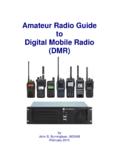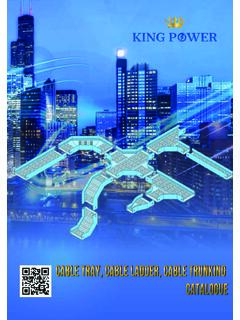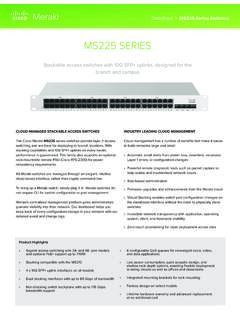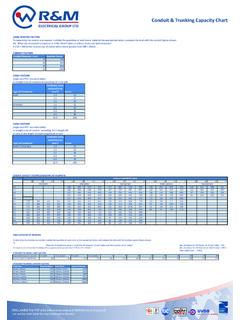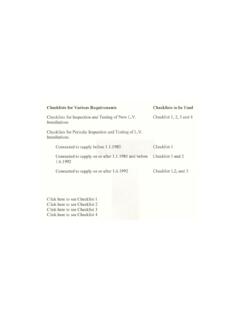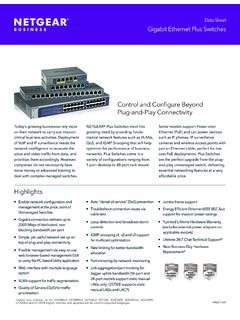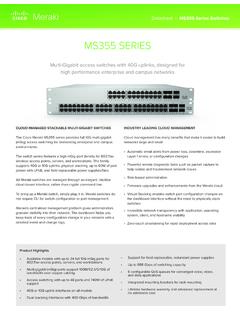Transcription of Amateur Radio Guide to Digital Mobile Radio (DMR)
1 Amateur Radio Guide to Digital Mobile Radio (DMR). By John S. Burningham, W2 XAB. February 2015. Talk Groups Available in North America Host Network TG TS* Assignment DMR-MARC 1 TS1 Worldwide (PTT). DMR-MARC 2 TS2 Local Network DMR-MARC 3 TS1 North America 9 TS2 Local Repeater only DMR-MARC 10 TS1 WW German DMR-MARC 11 TS1 WW French DMR-MARC 13 TS1 Worldwide English DMR-MARC 14 TS1 WW Spanish DMR-MARC 15 TS1 WW Portuguese DMR-MARC 16 TS1 WW Italian DMR-MARC 17 TS1 WW Nordic DMR-MARC 99 TS1 Simplex only DMR-MARC 302 TS1 Canada NATS 123 ---- TACe (TAC English) (PTT). NATS 8951 ---- TAC-1 (PTT). DCI 310 ---- TAC-310 (PTT). NATS 311 ---- TAC-311 (PTT). DMR-MARC 334 TS2 Mexico 3020-3029 TS2 Canadian Provincial/Territorial DCI 3100 TS2 DCI Bridge 3101-3156 TS2 US States DCI 3160 TS1 DCI 1.
2 DCI 3161 TS2 DMR-MARC WW (TG1) on DCI Network DCI 3162 TS2 DCI 2. DCI 3163 TS2 DMR-MARC NA (TG3) on DCI Network DCI 3168 TS1 I-5 (CA/OR/WA). DMR-MARC 3169 TS2 Midwest USA Regional DMR-MARC 3172 TS2 Northeast USA Regional DMR-MARC 3173 TS2 Mid-Atlantic USA Regional DMR-MARC 3174 TS2 Southeast USA Regional DMR-MARC 3175 TS2 TX/OK Regional DMR-MARC 3176 TS2 Southwest USA Regional DMR-MARC 3177 TS2 Mountain USA Regional DMR-MARC 3181 TS2 New England & New Brunswick CACTUS 3185 TS2 Cactus - AZ, CA, TX only DCI 3777215 TS1 Comm 1. DCI 3777216 TS2 Comm 2. DMRL inks 9998 ---- Parrot (Plays back your audio). NorCal 9999 ---- Audio Test Only * You need to check with your local repeater operator for the Talk Groups and Time Slot assignments available on your local repeater. ii Amateur Radio Guide to Digital Mobile Radio (DMR).
3 By John S. Burningham, Copyright 2015 by John S. Burningham, (W2 XAB), All Rights Reserved. Permission to distribute electronic (PDF format) copies of this document is granted to the following websites at for Amateur Radio usage only. ISBN-13: 978-163173195-2. Printed in the USA. th First Edition (6 Printing) February 2015 (Rev. H). iii CONTENTS. Forward v Dedication vi What is DMR? 1. Digital vs. Analog 3. Two-Slot TDMA 3. Talk Groups 5. Zones 6. Color Codes 6. Code Plugs 6. Scanning 7. Roaming 7. Simplex 8. Admit Criteria 8. Accessing a DMR Repeater 8. IPSC and Bridges 9. User Radios 10. Programming your Radio 14. Operating on DMR 15. Buying a Repeater 17. The End of the Beginning 19. For Further Information about DMR 20. Mototrbo is a Trademark of Motorola Solutions, Inc. c-Bridge is a Trademark of Rayfield Communications, Inc.
4 ABME+2 is a Trademark of Digital Voice Systems, Inc. D-Star is a Trademark of Icom America, Inc. Hamvention is a registered Trademark of the Dayton Amateur Radio Association, Inc iv Forward I was first licensed as WB8 GZR when I was a college freshman, and later as WB9 GQM, WB8 PUF, and currently as W2 XAB. I built my first analog FM repeater (GE Progress Line) in college and I have been active over the last 44 years in many aspects of Amateur Radio including FM, Packet, D-Star and now DMR. I worked in the Aerospace industry and spent a short time at Motorola before embarking on a career teaching computer technology spanning the last 15 years. I strongly believe in supporting local and national Amateur Radio organizations, including membership in the ARRL, AMSAT, and QCWA. To keep our hobby active and growing, it is important that users support our clubs and individual repeater operators.
5 We need to bring more youth and young adults into our hobby; the reality is that we are all getting older and many of us are closer to being silent keys than we wish to think about. I have passed my genes on to my harmonic (W2 JEN), my knowledge on to my students, and I hope I will leave Amateur Radio better off than when I first arrived on the scene. Amateur Radio is made up of many special interest groups (SIGs), CW, AM, SSB, FM, HF, VHF, UHF, microwave, contesting, DXing, public service, ARES, RACES, repeaters, education, clubs, fox hunting, RTTY, Packet, APRS, Satellite, SDR, D-Star , P25, DMR, NXDN, kit building, and Elmering, just to name a few. There will always be something new that generates interest in our hobby. There are three levels of involvement in DMR. The first is as a user, where you begin with a single Radio , and later, possibly you'll add a second or third.
6 The next level is as a repeater operator. You generally undertake this because there are no repeaters in your area or because you want better coverage. The third level of DMR participation is as a network operator. As a network operator, you purchase and manage your own IPSC bridge (such as the c-Bridge ) and build regional networks that interconnect to the other DMR networks. Amateur Radio is a hobby; Webster defines a hobby as a pursuit outside one's regular occupation engaged in especially for relaxation. I consider relaxation the most important part of a hobby. A second important part of any hobby is the friendships that are developed through participation in the hobby. v Dedication I dedicate this book to all my ham buddies, but especially WA9 TKK (my Elmer), W9JW (ex WB8 KLO), W2 JEN, and silent keys: W8 HQQ, K8 QOE, and W8 JGP.
7 I need to also mention my thanks to all my wives ( , , , , and ) for tolerating my hobby both at home and in the car. I especially thank my late father for sparking my interest in technology and for buying me my first computer kit, the IMASI 8080. Thanks to the Following I would like to thank KC6 OVD for being my local and first DMR mentor and for his help getting my first Mototrbo repeater working and online. Thanks to AA9VI and the DMR-MARC group for sparking my interest in Amateur DMR at the Dayton Hamvention in 2012, and lastly, special thanks to W1 NGS and NO7RF for their assistance in learning to configure Super Groups on my c-Bridge . Thanks to AA9VI, NE1B, NO7RF, K6 BIV, W1 NGS, WB8 SCT and W9JW for reviewing this document. A special thanks to the Dayton Amateur Radio Association and all those involved with giving the rest of us the annual Mecca of Amateur Radio (aka The Dayton Hamvention ).
8 To the ARRL all I can say is good luck in your second hundred years. Thanks to AMSAT for getting the hobby off the planet, and the QCWA. for reminding me I am getting old. vi What is DMR? Digital Mobile Radio (DMR) was developed by the European Telecommunications Standards Institute (ETSI) and is used worldwide by professional Mobile Radio users. [ ]. DMR is divided into three tiers. Tier I is a single channel specification originally for the European unlicensed dPMR446 service. It is a single channel FDMA kHz bandwidth; the standard supports peer-to-peer (mode 1), repeater (mode 2) and linked repeater (mode 3) configurations. The use of the Tier I standard has been expanded into radios for use in other than the unlicensed dPMR446 service. [ ]. Tier II is 2-slot TDMA kHz wide peer-to-peer and repeater mode specification, resulting in a spectrum efficiency of kHz per channel.
9 Each time slot can be either voice and/or data depending upon system needs. IP Site Connect (IPSC) for interconnecting repeaters over the Internet is vendor specific and is not part of the ETSI standards at this time. Most Amateur Radio implementations of DMR are using voice on both time slots. Tier III builds upon Tier II, adding trunking operation involving multiple repeaters at a single site. Not all manufacturers' trunking implementation is Tier III compatible. Vender specific protocols have expanded the trunking to multiple site operations. It is Tier II that amateurs are implementing in their Mototrbo . [ ] and Hytera [ ] infrastructure networks and the focus of this booklet. The IPSC protocols used by the different brand repeaters are not compatible; it is doubtful the equipment manufacturers will ever standardize for business reasons.
10 Any brand DMR (Tier II) user Radio will work on any Tier II system, although some manufacturers offer proprietary features. The current implementation of DMR utilizes the DSVI AMBE+2 . vocoder by agreement of the manufactures; it is not specified in the ESTI. standard. Most of the Radio manufacturers have implemented the vocoder in licensed software. The forward error correction in the AMBE+2 is an improvement of the voice quality of older vocoders such as used by D-Star . Amateur Mototrbo and Hytera DMR networks, from the end user standpoint, operate the same. Amateur Mototrbo networks are much larger, cover many more areas, and most are interconnected. I look forward to the day when the multiple vendor infrastructures can be 1. interconnected by the Amateur community. Not all the Amateur DMR.
